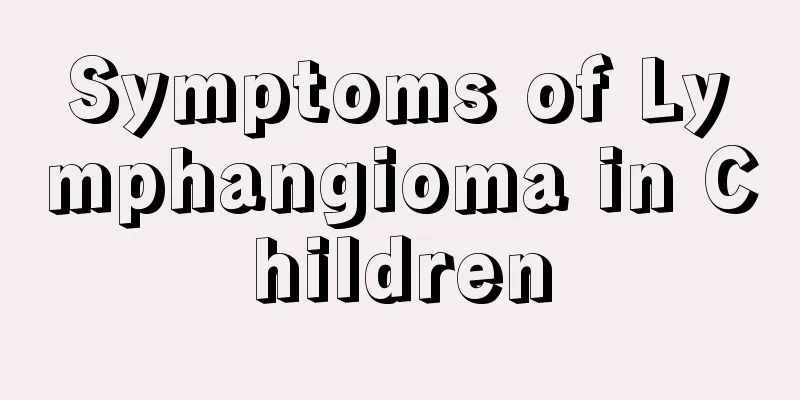Things to note for children with obstructive hydrocephalus

|
Since there are many different situations, young children will have many more physical conditions than adults, so at this time we must understand some of the children's conditions. So how much do you know about the precautions for children with early suspected obstructive hydrocephalus? The following editor will introduce to you some knowledge about the precautions for children with early suspected obstructive hydrocephalus. Let’s take a closer look! 1. Disease Overview Obstructive hydrocephalus is often accompanied by hydrocephalic cerebral edema. This type of hydrocephalus is actually caused by a large amount of cerebrospinal fluid from the ventricles invading the atrophic brain tissue, causing it to contain excessive tissue fluid. 2. Clinical manifestations In young children, there may be symptoms such as enlarged head, "sunset sign", vomiting, visual impairment, difficulty in sucking and feeding, esotropia, laryngeal sounds, drooping head, limb weakness or spastic paralysis, intellectual development disorder, and even convulsions and drowsiness. In adults, symptoms include intermittent headaches, head swelling, heaviness, dizziness, tinnitus, ear congestion, decreased vision, and lower limb weakness. 3. Precautions for children with early suspected illness: 1. Head circumference measurement: Measure the forehead and occipital circumference regularly every 2 months. The average head circumference of normal infants in my country is shown in Table 53-1. After one year old, it increases by 2cm in the second year, 2cm in the third to fourth years, and a total of 1.5cm in the fifth to tenth years. It should be noted that in older children, a normal head circumference curve does not exclude progressive ventriculomegaly. 2. Transillumination method (light transmission test) When the cortex is thinner than 1 cm, the light transmission test is positive. However, it should be noted that the transillumination test may also be positive when there is subdural exudation, ventricular puncture malformation, subgaleal effusion, etc. 3. Skull X-rays of hydrocephalus in infants may reveal enlarged head, craniofacial disproportion, thinning skull, separation of cranial sutures, and enlarged anterior and posterior fontanelles or delayed closure. In older children, enlarged sella turcica, absorption of the posterior clinoid process and other signs of intracranial hypertension may be shown. In addition, the low lambdoid suture characteristic of aqueductal stenosis and the posterior fossa bulge seen in Dandy-Walker malformation can be demonstrated. 4. When CT scan shows communicating hydrocephalus, the ventricular system and the cistern magnum are both enlarged; if there is aqueduct stenosis, only the lateral ventricles and the third ventricle are enlarged, while the fourth ventricle is normal. 5. Ventriculography Ventricular air or iodine water contrast is helpful in estimating the size of the ventricles and the location of obstruction. 6. When using isotopes to examine hydrocephalus, isotope cisternography shows that the radioactive imaging agent flows back into the ventricles, causing the ventricles to expand and the radioactivity is cleared slowly. 24 hours after the angiography, there is still no radioactivity on the convex surface of the brain and on both sides of the superior sagittal sinus. If isotope ventriculography is performed, the site of ventricular obstruction can also be determined. In fact, mothers don’t have to worry too much. We cannot sit idly by if the baby has this condition. Only when we pay attention to these conditions can the child recover. So how much do you know about some of the precautions for children suspected of early obstructive hydrocephalus? I hope you understand it clearly enough. I hope your baby can recover quickly! |
<<: What are some tips for baby's stuffy nose?
>>: Causes of toothache in 6-year-old children
Recommend
Solution to zinc deficiency in four-year-old babies
Zinc deficiency in four-year-old babies has becom...
Early education of language and crawling skills for one year and eight months old babies
A one year and eight month old baby is almost abl...
How to treat periodontitis in children?
Many parents and friends are worried about their ...
Five ways to keep your baby away from prickly heat in summer
Tip 1: Temperature control A hot and humid enviro...
Newborns have less stool and more farts
The birth of a baby is a very happy thing for a f...
Is it effective to treat children's cough?
In daily life, it is common for children to catch...
What causes lower respiratory tract infection in children?
Children have weaker immunity and are therefore m...
Breastfeeding milk quantity standard table
Breastfeeding is the healthiest and most nutritio...
Precautions for Qingfei Huatan Granules for Children
We have all heard of Children's Lung Clearing...
What should a four-year-old child eat when he has a cough?
Colds, coughs and fevers are diseases that are ve...
What to do if children have uneven teeth
Children's tooth replacement is a stage that ...
What are some tips for baby’s stuffy nose?
Are there any tips for baby’s stuffy nose? In mot...
The child coughs with a hollow sound
The growth of children is what parents care about...
Will children have convulsions due to calcium deficiency?
Symptoms of calcium deficiency in children may ca...
What should I do if my child has not grown in height for half a year?
Children will start to grow when they reach a cer...









